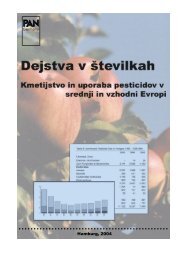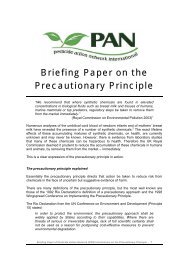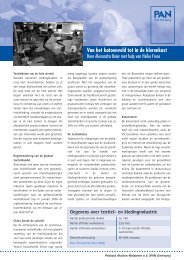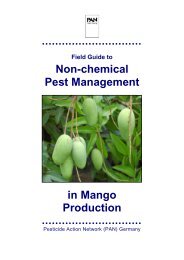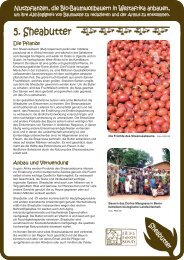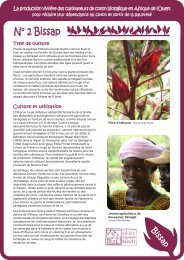Field Guide: How to Grow Crops without Paraquat - Online ...
Field Guide: How to Grow Crops without Paraquat - Online ...
Field Guide: How to Grow Crops without Paraquat - Online ...
You also want an ePaper? Increase the reach of your titles
YUMPU automatically turns print PDFs into web optimized ePapers that Google loves.
<strong>Field</strong> <strong>Guide</strong>: <strong>How</strong> <strong>to</strong> Live and Work Without <strong>Paraquat</strong><br />
resistant <strong>to</strong> 2,4-D on some rice fields in Malaysia,<br />
Thailand, and the Philippines.<br />
Methods of control<br />
1. Proper seed selection<br />
2. Thorough land preparation by plowing and<br />
harrowing<br />
3. Rice seedbeds should be free of weeds<br />
4. Regular plant moni<strong>to</strong>ring<br />
5. Proper water and fertilizer management<br />
6. Closer plant spacing <strong>to</strong> prevent the germinating<br />
seeds of the weeds being exposed <strong>to</strong> sunlight<br />
7. Hand weeding<br />
8. Crop rotation<br />
Horseweed<br />
Scientific name: Conyza canadensis, Erigeron<br />
canadensis<br />
Synonyms: Canadian horseweed, Canadian<br />
Fleabane, Mare's tail<br />
and beans and are the source of infestation for the<br />
next cropping season. It is an alternate host for most<br />
agricultural pests. Its stem has medicinal properties. It<br />
is made in<strong>to</strong> a tea <strong>to</strong> treat diarrhea and kidney and<br />
respira<strong>to</strong>ry problems. Oil of erigeron is taken from the<br />
fresh plants and used against intestinal parasites.<br />
Studies shows that horseweeds become resistant <strong>to</strong><br />
<strong>Paraquat</strong>, Atrazine, Glyphosate at some corn, cot<strong>to</strong>n,<br />
and soybeans farms, pastures, orchards, vineyards in<br />
some parts of Europe, USA, and Japan (Weed<br />
Science, 2005).<br />
Methods of control<br />
1. Proper seed selection and proper choice of<br />
cultivars<br />
2. Thorough land preparation<br />
3. Regular field moni<strong>to</strong>ring. Scout your field <strong>to</strong><br />
identify the weeds and <strong>to</strong> know what immediate<br />
actions <strong>to</strong> undertake.<br />
4. Hand weeding<br />
5. Cutting the weeds before they flower<br />
Jimsonweed<br />
Scientific name: Datura stramonium<br />
Synonyms: Angel's trumpet, Devil's trumpet,<br />
James<strong>to</strong>wn weed, Stinkweed,<br />
Thorn apple<br />
Habitat<br />
Cultivated and uncultivated soils<br />
Affected crops<br />
Almost all agricultural crops<br />
Distribution<br />
Worldwide<br />
Description<br />
The stem is simple, erect, and has no branches. It is<br />
covered with hairs. The leaves are clustered radiating<br />
the stem and becoming smaller at the <strong>to</strong>p. The<br />
margins are <strong>to</strong>othed. The flower head is highly<br />
branched that arising at the <strong>to</strong>p of the main stem with<br />
white or yellow or pink flowers.<br />
Effects and impacts<br />
Horseweed infests most agricultural lands. Its<br />
numerous seeds easily mix with the harvested cereals<br />
Habitat<br />
Cultivated and non-cultivated areas<br />
Affected crops<br />
Corn, sorghum, cot<strong>to</strong>n, legumes, pota<strong>to</strong>, banana, and<br />
other summer crops<br />
Description<br />
The stem is smooth, pale-green, and fully branched.<br />
The leaves are irregularly cut and <strong>to</strong>othed, eggshaped,<br />
and with green or purplish coloration. The<br />
flowers are white or purple and funnel-shaped. The<br />
fruit is green, oval, hard, and spiny. Each fruit may<br />
•••••••••••••••••••••••••••••••••••••••••••••••••••<br />
22 Pesticide Action Network (PAN) Germany



